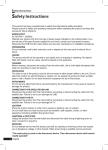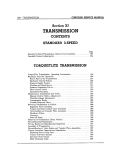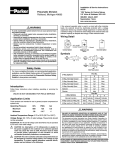Download Parking Brake
Transcript
PARKING BRAKE 4-1 GftOUP 4 PARKING BHAKE CONTENTS Page Data and S p e c i f i c a t i o n s . . . . . . . . . . . . . . . . . . . . . . . . . . . . . . . . . . . . . . . . . . . . . 1 External Contracting Type Parking Brake 2 ................ .... Parking Brake Band Lining 3 Parking Brake Internal Expanding Type 5 Parking Brake Cable 6 Service Diagnosis 6 DATA AND SPECIFICATIONS Type Location . . ................ f c ...................... Internal Expanding External Contracting (Manual Transmission) Propeller Shaft at Rear of Transmission Drum Diameter 7 inches Lining Type Internal—Moulded Asbestos Width 2 inches Thickness % inches 2 Clearance . . . \ . . . . . . . . . . . . . . . . . . . . . . . . . . . . . . . . . . . . . . . . . . . . . .015 to .020 Inches TIGHTENING REFERENCE Foot-Pounds Parking Brake Cable Bracket Clamp Bolt 20 Parking Brake Lever to Instrument Panel 20 Parking Brake Adjusting Bolt Cover Bolt Transmission Shaft Flange Bolt Nut % . . . . . . .................... %.............................. ........................... Inch-Pounds 130 95 6 35 50 4-2 PARKING BRAKE GROUP 4 PARKING BRAKE The foot operated parking brake pedal and release handle is located to the left of the steering column. The brake is applied by pressing down firmly on the pedal The brake is released when the "T" shaped handle is pulled and depressed. The pedal and release handle are serviced as a unit and need only periodic lubrication. A steel enclosed brake cable connects the pedal and release handle assembly to the parking brake located on the rear of the transmission. A l l Chrysler Models equipped with the standard three speed transmission have a 7 inch external contracting parking brake (Fig. 1). EXTERNAL CONTRACTING TYPE PARKING BRAKE The external type parking brake consists of a brake drum bolted to the universal joint flange and an external contracting type band, mounted at the rear of the manual transmission (Fig. 1). The brake lining should be replaced i f the lining has worn so that the depth of the rivet counterbore. is less than V32 inch. When relining the parking brake, care should be taken not to distort the band from its original shape. Parking brake drums should be replaced i f the braking surface is worn, rough, scored or damaged. Fig. 1—External Contracting Brake (Disassembled View) PARKING BRAKE 4-3 S E l f l C E PBOCEDUHES PARKING BRAKE BAND LINING (4) Drill and counterbore the end rivet holes and rivet the ends of the lining. a. Removal (1) Eemove the cotter pin, pivot pin and lever assembly (Fig. 1). (2) Remove the adjusting nut, bolt and springs. (3) "Remove the guide screw lock nuts, guide screw and springs. (4) Remove the anchor screw locking wire and anchor screw. (5) 'Remove the band assembly from the drum and off of the.propeller shaft. CAUTION ' Take care not to lose the anchor spring as the band is pulled off of the brake anchor. b. Reining Broke Band (Band Removed) If the lining is not already tailored to fit the band, the lining must be cut to Insure tight adherence to the band. Cut the lining % inch longer than the inside contour of the band. The rivet hole counterbores must be % of thickness of the lining. (1) Cut off the lining- rivet heads and remove the old lining. (2) Thoroughly clean the inside surface of the brake band. (3) Place the lining within the brake band with the ends of the lining flush with the ends of the band (the center of the lining will have a slight hump in i t ) . (5) Compress the hump in the center of the lining and force the lining snugly against the brake hand. (6) Drill, counterbore and rivet the balance of the lining. (T) Chamfer the two ends of the lining to reduce noise and- grabbing effect. c. Installation (1) Position the brake band over the propeller shaft. (2) Install the anchor spring into the recess of the brake anchor. (3) Holding the brake anchor spring compressed, slide the brake band over the drum and anchor. (4) Install the anchor screw finger tight. (5) Install the guide bolt and locking bolts. (6) Install the adjusting bolt, springs, and adjusting nut. (7) Install the pivot pin through the lever assembly and spacer. Install a new cotter pin. d. Adjustments Before adjusting the parking brake, inspect the vertical free play between the brake anchor bracket and the brake anchor (Fig. 2). I f free play exceeds .005 inch brake band distortion may occur when brakes are applied. Excessive clearance may be reduced by compressing the anchor bracket in a vise. (1) Place the parking brake pedal and lever assembly in the fully released position. (2) Using a feeler gauge, adjust the anchor bolt so that the clearance between the lining and the drum is from .015 to .020 inch. (3) Install locking wire through the anchor screw. NOTE: The locking wire should not be drawn tight as it may distort the position of the brake band. Fig. 2—Parking Brake Adjustment (4) Adjust the guide screw so there is a slight drag from the bottom half of the brake band. (5) Tighten the adjusting nut so that there is only a slight drag from the top half of the brake band. (8) Apply the parking brake several times and test for excessive dragging when released. 44 PARKING BRAKE BRAKE ANCHOR WASHER BRAKE SHOE ANCHOR PIN BRAKE ANCHOR SHOE GUIDE OUTPUT SHAFT REAR BEARING OIL SEAI BRAKE SHOE OPERATING LEVER LINK BRAKE SUPPORT GREASE SHIELD BRAKE SUPPORT GREASE SHIELD SPRING BRAKE SHOE ASSEMBLY BRAKE SUPPORT BRAKE SHOE RETURN SPRING CABLE GUIDE CLAMP BRACKET ASSEMBLY BRAKE SHOE ADJUSTING SCREW BRAKE SHOE ADJUSTING SLEEVE BRAKE SHOE ADJUSTING NUT 53x58 fig. 3—Parking Brake Internal Expanding BRAKE ANCHOR SHOE GUIDE BRAKE ANCHOR WASHER BRAKE SUPPORT GREASE SHIELD BRAKE SHOE OPERATING LEVER LINK BRAKE SHOE ANCHOR PIN BRAKE SHOE ANCHOR BRAKE SUPPORT BRAKE SHOE & LINING ASSY BRAKE SUPPORT SPACER SHAFT FLANGE & BRAKE DRUM ASSY BRAKE ADJUSTING / SCREW COVER / BRAKE ADJUSTING SCREW COVER SCREW SHAFT FLANGE WASHER SHAFT FLANGE NUT BRAKE SUPPORT GREASE SHIELD SPRING BRAKE SHOE RETURN SPRING BRAKE SHOE OPERATING LEVER SCREW BRAKE SHOE OPERATING LEVER BRAKE SHOE OPERATING LEVER SCREW LOCKWASHER BRAKE SHOE OPERATING LEVER SCREW NUT BRAKE SHOE ADJUSTING SCREW BRAKE SHOE ADJUSTING NUT BRAKE SHOE ADJUSTING SLEEVE 53x3A Fig. 4—Parking Brake Internal Expanding (Disassembled View) PARKING BRAKE PARKING I R A K (Internal Expanding Type) 4-5 OPERATING*? LEVER ^CONTROL CABLE UIDE CLAMP CLAMP BOLT, NUT AND LOCK WASHER (Figures 3 and 4) All Models equipped with the automatic transmission have a 7 inch internal expanding two shoe parking brake Fig. 3). a. Disassembly (1) Disconnect the propeller shaft,at the transmission. ^ . (2) Engage the holding Tool C-3281 with the J ^ j f C O N T R O L CABLE • companion flange, loosen and remove the companion ty^gftMUlBfltf*^ CABLE SPRING flange nut, lockwasher and flatwasher. SHOE ADJUST SCREW, NUT AND SLEEVE • BALL END 0\ CONTROL CABLE 50x137B (3) Install'the puller Tool C-452 on the companion flange, removing flange and brake drum. Fig. 5—Rear View of Internal Parking Brake (4) Disengage the ball end of cable from the operating lever (Fig. 5). stalled in the reverse position, adjustment would (5) Separate the shoes at the bottom, allowingbe difficult. the brake.shoe adjusting nut, screw and sleeve to (6) Place the outer anchor guide over the anchor, drop out, then release the shoes. then attach the shoes with the retaining washer. (6) Pry the brake shoe return spring up and over (7) Turn the brake shoe adjusting nut until the the right brake shoe pin, then work the spring out shoes are in the fully released position, then install of the assembly. the brake drum. (7) Pry out the brake shoe retaining washer and NOTE: Be sure the brake shoes are centered on the remove outer guide. backing plate and are free to move. (8) Slide each shoe out from under the guide spring. (As the shoes are removed, the operating (8) Adjust the brake shoes and control cable as outlined below. lever strut will drop out of place.) (9) Separate the operating lever from the right c. Adjustment brake shoe by removing nut, lockwasher and bolt. The brake has now been disassembled as far as (1) Remove the adjusting screw cover plate. necessary for replacement of worn or damaged parts. (2) Turn the brake shoe adjusting nut, as shown in Figure 5, to decrease shoe-to-drum clearance until a slight drag is felt on the drum. Back off the adb. Assembly (Figure 3) justing nut at least one full notch (using spanner (1) Assemble the operating lever to the right wrench Tool C-3723) or until brake drum is free. brake shoe. PARKING BRAKE WASHER (2) Slide the right and left hand brake shoes unCABLE SEAL der the guide spring and up on top of the inner anchor guide. (3) Spread the shoes and insert the operating lever strut with the wide slot toward the operating lever, and stamped "top" facing up. (4) Work the shoe return spring under the grease shield spring and secure ends in proper holes in webs of shoes, as shown-in Figure 3. (5) Spread the bottom of both shoes apart and install the brake shoe adjusting nut screw and sleeve. NOTE: Install the adjusting nut> screw and sleeve in the proper position, as shown in Figure 3. If in- ADJUSTING NUT PARKING BRAKE LEVER ASSEMBLY 62X85 Fig. 6—Parking Brake PedaL Lever and Cable Assembly (Models SOL SC-2, SC-3) 4-6 PARKING BRAKE (5) Pry the ball end of the cable up and out of the operating lever slot with a screwdriver. (6) Remove the control cable from the guide clamp bracket. b. Installation (1) Slide the cable into the guide clamp bracket at the brake support. Insert Tool C-3015 between the spring retainer washer and the ball on the end of cable. (2) Hook the cable into the slot in the operating lever, with the lever between the ball and the washer, as shown in Figure 5. The cable must be installed so that the cable conduit is not pulled taut between any of the fastening points. To provide free cable operation, care must be used to prevent kinking of the housing, also, all bends must have a radius of 6 inches or more. Fig. ?—Parking Brake Pedal and Lever Assembly (Models SY-1) Be sure the two raised shoulders on the adjusting nut are seated in the groove on the adjusting sleeve. (3) Test the parking brake lever for travel When properly adjusted, there should not be more than 31/4 Inches of parking brake pedal travel Never substitute a brake shoe adjustment by adjusting the cable. (4) Install the adjusting screw cover plate. PARKING BRAKE CABLE a. Removal (Figures 6 and 7) (1) Release the parking brake. (2) Remove the cable adjusting nut from the end of the cable at the upper end of parking brake lever. (3) From the engine compartment, remove the upper end of cable from dash panel (4) Loosen the guide clamping bolt at the brake support, as shown in Figure 5, then remove the adjusting screw cover plate. (3) Route cable from transmission up the front of dash panel (4) Install the plastic seal and washer on the cable (Fig. 4) and insert the cable through dash panel opening. (5) Install the housing retainer. (6) Insert the threaded end of the cable in the pedal trunnion, depress the foot pedal to do so, return foot pedal to released position, and install the cable adjusting nut. (7) Tighten the cable adjusting nut so that the nut is seated on the trunnion without pulling any additional cable through the dash panel. (8) After the adjustment has been completed, apply and release the foot pedal several times. Then, when fully released check to insure that the cable adjusting nut is seated on the trunnion. Readjust if necessary. (9) To check for correct adjustment, apply approximately 60 pounds-foot pressure on the pad and measure pedal travel The travel at the pad should not be more than 3 ^ inches. With the foot pedal fully released, the parking brake must release and the propeller shaft revolve freely. SERVICE DIAGNOSIS Condition Dragging Brake Possible Cause Correction (a) Improper cable or brake adjust- (a) Adjust brake shoes and cable. ment. (b) Broken brake shoe return spring. (b) Replace brake shoe return spring. PARKING BRAKE 4-7 SERVICE DIAGNOSIS—CONT'D. Condition Possible Cause (c) Broken brake support spring. (d) Oil soaked brake lining. (e) Bent or distorted drum. (f) Bent or broken brake shoe. (f) Frozen brake pedal assembly. Overheating Brake (a) Improper cable or brake adjustment. Broken or misaligned brake sup(b) port spring. (c) Broken or disconnected brake shoe return spring. (d) Missing brake shoe anchor retaining washer. (e) Bent or distorted drum. (f) Bent or broken brake shoe. («r) Frozen brake pedal assembly. Correction (c) Eeplace brake support spring. (d) Replace transmission oil seal and brake shoes. (e) Replace brake drum. (f) Replace brake shoe. (S) Lubricate and free up brake pedal assembly. (a) Adjust brake shoes and cable. (b) Replace or align brake support spring. (c) Replace or align brake. (d) Install new brake shoe retaining washer. (e) Replace brake drum. (f) Replace broken brake shoe. (g) Lubricate and free up brake pedal assembly. Brake Grabbing (a) Improper brake or cable adjust- (a) Adjust brake and cable. ment. (b) Oil soaked brake lining. (b) Replace transmission oil seal and brake shoes. Clean off drum. (c) Loose brake drum. (c) Tighten brake drum. (d) Loose or broken anchor pin. (d) Replace anchor pin. (e) Warped or bent brake drum. (e) Replace brake drum. (f) Scored or cracked brake drum. (f) Replace brake drum. Brake Chattering (a) Improper brake or cable adjust- (a) Adjust brake and cable. ment. (b) Oil soaked lining. (b) Replace transmission oil seal and brake shoes. Replace brake shoes. (c) Worn or distorted brake lining. (c) (d) Loose anchor pin. (d) Replace anchor pin. (e) Replace brake drum. (e). Scored or cracked drum.







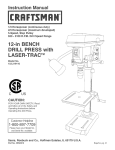


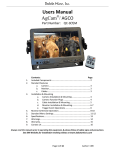

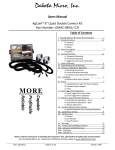
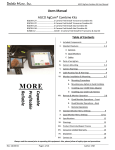
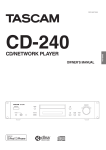
![Cover [IP7361]_Outline](http://vs1.manualzilla.com/store/data/006290601_1-2c5dec26af4e44ba77ecb21269762c6c-150x150.png)


